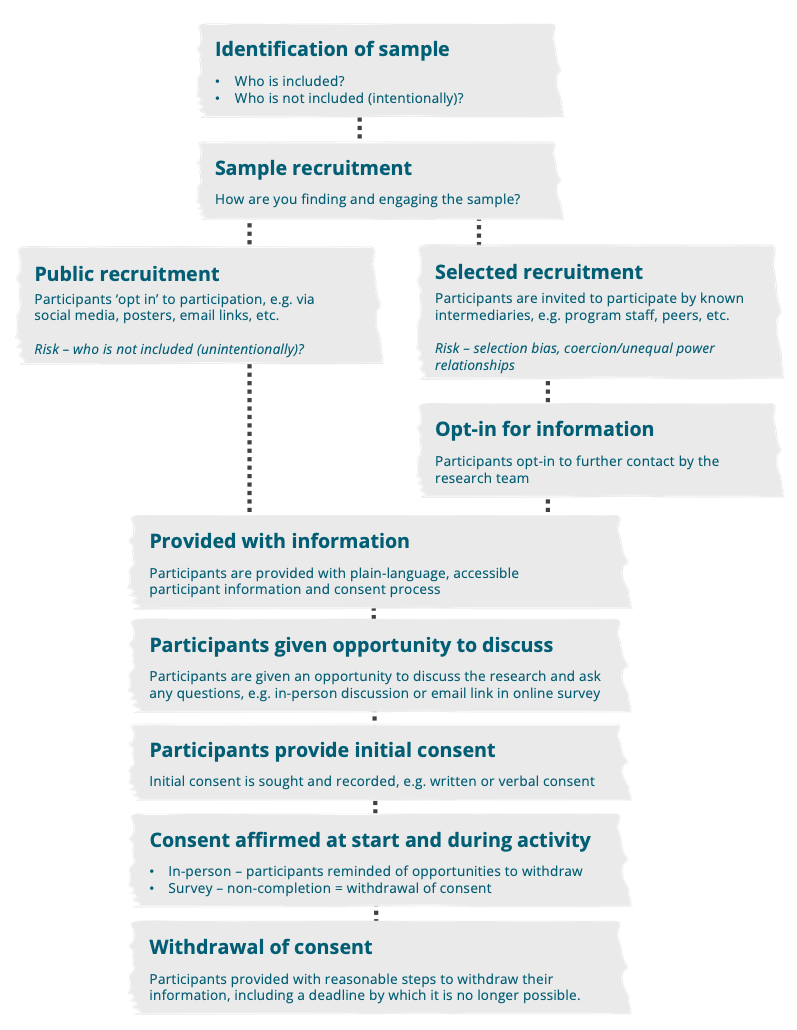The tl;dr:
We made another flow chart. Well, Jo van Twest Farmer did. It’s about consent. It’s a clever flow chart because it also doubles as a checklist for your projects. You can download it here.
Introduction
Consent is one of the most vital elements of delivering ethical evaluation and research. It’s also one of the easiest things to integrate in your projects. However, it’s also one of the most easily overlooked elements of data collection. And it can be far more complex than it first seems. That’s why it gets two chapters in theNational Statement (2.2 and 2.3). They summarise the rationale for consent extremely well:
…consent should be a voluntary choice, and should be based on sufficient information and adequate understanding of both the proposed research and the implications of participation in it.
What is needed to satisfy these conditions depends on the nature of the project and may be affected by the requirements of the codes, laws, ethics and cultural sensitivities of the community in which the research is to be conducted.
Moreover, consent is more than a formal requirement; it’s an opportunity for building a relationship with participants and stakeholders, and for enabling them to ask questions and discuss the implications of the work and their participation. In this sense, consent processes are integral to assuring that the principles of justice, beneficence, and respect are met within projects
If consent is complex, then why make a flow chart?
We’ll be honest. No flow chart is ever going to cover the full range of evaluation and research scenarios. It’s one of the reasons we have developed determinations - to enable discussion when the flow chart doesn’t provide an answer. Moreover, any consent process needs to be developed with reference to the discussions at chapters 2.2 and 2.3 of the National Statement, as well as Section 4, as these provide greater detail on specific scenarios and risks to consider.
Nevertheless this flow chart is a starting point for identifying the things you need to consider and have in place to support ethical evaluation and research.
The flow chart

Please right click and open the image in a new tab/window to view it at full size, or you can get a PDF version at the bottom of the page.
Jo van Twest Farmer has developed an excellent one-page flow chart to support project and process design. It’s especially clever because you can also use it as a checklist. It reads from top to bottom, and sets out the key questions and steps you need to consider and address when putting in place a consent process.
Importantly, it starts well before the design of the instrument, with the first steps being about understanding the people that you want to involve in data collection. After all, consent mechanisms need to be tailored to the participant. The flow chart then splits based on the recruitment mechanism (public (open) or selective), identifying potential risks for each mechanism.
The flow chart then proceeds through the steps taken in the data collection process, reinforcing that consent is an ongoing dialogue with the participant across the project and in many cases, beyond the project.
The potentially controversial part
It’s in the second last box. Did you spot it? As a default, our advice is that non-completion of a survey is a withdrawal of consent. Yes, that’s right.
If you’ve been in the market research space, this might come as a shock. After all, dropout rates on surveys are high, and they do not necessarily mean that the respondent has explicitly withdrawn consent. They might have been distracted, they might have gotten bored, there’s any number of reasons. Market researchers are used to using these “partial” responses either as-is, or imputing incomplete data based on other responses.
But from an ethical standpoint, this is risky. Most market research platforms don’t have a mechanism built in by default to differentiate between the boredom/distraction non-response and the withdrawal of consent non-response. Without a mechanism, there is the risk that data may be used from someone who has withdrawn their consent, even if it is implicitly. So to mitigate this risk there are two options:
- Remove incomplete data
- Put in a mechanism
Thankfully, mechanisms do exist, including:
- reaffirming consent before survey sections
- providing opt-out of certain sections or questions (e.g. sensitive demographic questions such as income)
- reminder emails to incomplete respondents (where this is possible)
Putting in one or more of these can help to overcome dropout rates while ensuring consent is informed and explicit.
This doesn’t cover every scenario
Yes, we mentioned that earlier, but it’s worth reinforcing. After all, there’s a lot of elements to a project and to consent. For example, the flow chart doesn’t get into detail about secondary uses of collected data (e.g. when you use data collected in one project as part of a later project). That subject is worthy of its own discussion, and it’s on our list of resources to develop.
But this flow chart covers the core elements of consent, and hopefully it helps you to think about and put in place high quality processes. If you have any feedback let us know, or if there’s a resource you’d like to see us make then get in touch. We also have our determinations process if there’s a specific scenario that you want advice on.
Can I have a copy of the chart?
Yes! Here's a PDF: